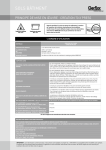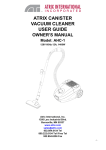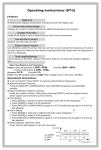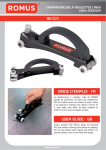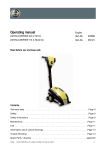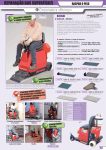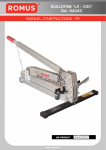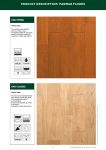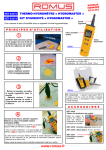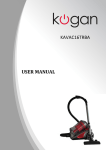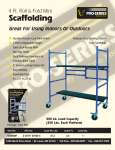Download Creation 30 X`Press
Transcript
FLOORS IN BUILDINGS LAYING PRINCIPLE: CREATION 30/55 X’PRESS Ambient temperature Min: 15° C Before laying the flooring, it is a good idea to inspect it and to identify any problems with the appearance. If there are visible defects, please notify GERFLOR and wait to hear from them before laying the flooring. Substrate temperature Min: 15° C 1. AREAS OF APPLICATION CREATION 30 X’PRESS PLANKS AND TILES MATERIALS CREATION 55 X’PRESS PLANKS AND TILES DESCRIPTION 4 mm including 0.30 of wear layer 4 mm including 0.55 of wear layer UPEC OR EUROPEAN CLASSIFICATION UPEC: U2SP3 E2 C2 European: 23-31 Technical Report request in progress UPEC: U3 P3 E2 C2 European: 32-41 Atex N°2098 AREAS OF USE Please refer to the Material selection guide in GERFLOR’s general catalogue SUBSTRATES ALLOWED CONCRETE FLOOR, LIQUID SCREEDS, PAINTED CONCRETE, LEVELLING CONCRETE In case of irregularity, apply a levelling compound. Sand, vacuum carefully and apply a primer. Consult glue and primer manufacturers such as Akzo Nobel, Bostik, HB Fuller, F Ball, Mapei, Uzin, etc. Gerflor recommends that you refer to the technical specifications of these primers for instructions. ANHYDRITE SCREED ONLY FOR E1 CLASS PREMISES In case of irregularity, apply a levelling compound. Sand, dust off. Apply a primer recommended in the screed’s Technical Report to protect the surface from dust. Consult glue and primer manufacturers such as Akzo Nobel, Bostik, HB Fuller, F Ball, Mapei, Uzin, etc. Gerflor recommends that you refer to the technical specifications of these primers for instructions. TILES The floor surface must not have any uneven areas, and the joints must not be recessed; otherwise, fill them with a grouting product. Clean thoroughly and then lay the Creation Xpress planks / tiles. (It may be necessary to apply a primer depending on the surface finish of the tiles). RAISED ACCESS FLOORS ONLY FOR CREATION 55 X’PRESS The floor surface must not have any uneven areas and the joints must not be curved. The application of a primer may be necessary depending on the surface finish. COMPACT PVC FLOORS The floor covering must be bonded in all places. Thoroughly clean the existing floor. Otherwise, the entire flooring will have to be taken up and the substrate prepared from scratch. PVC FLOORS WITH SOUNDPROOF LAYER (FOAM) Creation 30 X’Press has only class CEN 31. Creation 55 X’Press has only class CEN 32. The floor covering must be bonded in all places. Thoroughly clean the existing floor. Otherwise, the entire flooring will have to be taken up and the substrate prepared from scratch. VINYL ASBESTOS Refer to the Technical Guide for Overlaying asbestos floors available at www.gerflor.com LAYING ON FLOORBOARDS AND WOOD-BASED PANELS The panels must not have any unevenness between them. Parquet nailed onto battens spaced no more than 0.30 m apart, ventilated. Lining board (19 mm) fixed to nailed and ventilated parquet. Apply primer to the panels. PVC COLLEE SUR SOL CHAUFFANT : Nous ne recommandons pas de recouvrir un revêtement PVC afin d’optimiser la valeur énergétique du sol chauffant UNDERFLOOR HEATING (floor temperature < 28°C) The regulations require: ≤ 0,15 m² x ° Kelvin / Watt Possible RADIANT ELECTRIC UNDERFLOOR HEATING The regulations require: ≤ 0,15 m² x ° Kelvin / Watt Not recommended LOW TEMPERATURE WATER REVERSIBLE UNDERFLOOR HEATING The regulations require: ≤ 0,13 m² x ° Kelvin / Watt Possible Please contact us if the substrate is not in this list. SUBSTRATES NOT ALLOWED (NON-EXHAUSTIVE LIST) CALCIUM SULPHATE BASED LIQUID SCREED LEVELLED OR NOT IN E2 OR E3 PREMISES WOODEN SUBSTRATES: FLOORBOARDS ON JOISTS, FLOATING PARQUET, GLUED PARQUET, FLOATING PARTICLE BOARDS, OSB BOARDS, LAMINATES RUBBER LAYING ON SOUNDPROOFING OR INSULATING UNDERLAYER TEXTILE FLOORING (CARPET) LINOLEUM / LINOLEUM WITH BACKING FOAM TILES AND LVT SNAP-TOGETHER PLANKS IMPORTANT : : The information in this document is valid from: 01/04/2015 and is subject to change without notice. In the face of continuous technical improvements, before starting any work, our customers should check with us that this document is still in force. LAYING CONDITIONS STATIC LOAD RESISTANCE Floor covering laid in temperature-regulated premises. TEMPERATURE BETWEEN 15 and 25°C Acceptable temperature range after installation: +10°C to +30°C. Beyond these values, the planks must be entirely glued all over the surface with a glue that is resistant to high temperatures, and in areas with a glazed opening and exposed to direct sunlight, you are recommended to install temperature regulation (air conditioner) or to stop the direct sunlight (curtains, blinds) reaching the material. Installations in areas close to bay windows or skylights (considerable temperature variation) will require acrylic adhesives such as Gerflor Clim Adhesive or Bostik Power Elastic. In case of a temperature > 50°C, we recommend a two-part polyurethane adhesive. ≤ 200 kg/support and < 30 kg/cm2 2. FLOOR PREPARATION 2.1. NEW or REFURBISHED substrate requirements The laying must be done on a flat floor, without any permanent glue or adhesive residue. −The flatness of the floor must be < 5 mm under the 2m rule (3mm under the 2 m rule for toppings), with no uneven areas. −Moisture content: < 4.5% for concrete floors and liquid cement screed and < 0.5% for anhydrite screeds and wooden substrates. 2.2. PREPARATORY WORK ON CONCRETE SUPPORTS Preparation: The surfaces should be prepared with care so as to remove any soiling, laitance, treatment products or any other foreign body. If the substrate does not meet the requirements, a substrate preparation must be carried out: •With a substrate moisture content of < 4.5%, the grouting must meet class P3 specifications Crack treatment: Treat cracks before applying a patching compound if the unevenness is > 1 mm or there is a gap of > 4 mm. Joint treatment: Contraction joints: Treat joints before applying a patching compound. Construction joints: Similar to cracks, same treatment. Expansion joint: Flush joints: ROMUS profile CJ-20-5 or 3 may be suitable. Expansion joints with overlay profile: The profile is fitted over the flooring and is secured on one side only. 3. INSTALLATION 3.1. LAYING CONDITIONS The planks / tiles must be stored in the room in which they are going to be laid for at least 24 hours before laying (minimum ambient temperature 20°C). To avoid major colour differences or repeated designs, mix the planks / tiles from several different boxes from the same series. The room temperature must be between 15 and 25°C. Beyond or below these temperatures, during installation, the material may contract or dilate over time. For these reasons, installation close to bay windows or skylights (considerable temperature variation) requires special precautions to be taken (see laying conditions). 3.2. LAYOUT Unless otherwise specified in market-specific documents, the arrangement of planks / tiles must follow these principles: −Each enclosed room must be considered separately. −The planks / tiles used in one room must belong to the same batch. −The contractor must carefully analyse the plank / tile layout to meet these requirements: The planks / tiles must be oriented towards the wall with the main window, or lengthwise. In corridors, the planks / tiles must be arranged in the direction of traffic. At the edges, the width of the planks / tiles must, if possible, be the same on both sides. At the ends of rows, the length of the planks / tiles must be greater than 1/3 of a plank. The length of the planks / tiles and the offsets between them must be greater than 1/3 of a plank. Window 3.3. MARKING OUT THE AXIS Determine the laying direction (the planks should preferably run in the same direction as the light entering the room). Mark a centre line on the floor, dividing the room in two in the laying direction. To ensure that the cuts are the same on each side, mark out the axes so that the cut planks / tiles are > 1/3 of their format in both directions. 3.4. LAYING PLANKS / TILES 3.4.1. TOOLS −Chalk (chalk line) −Ruler, knife, cut-resistant gloves, tape measure −30/50 kg roller Door SOLS BÂTIMENT LAYING PRINCIPLE: CREATION 30/55 X’PRESS FLOORS IN BUILDINGS LAYING PRINCIPLE: CREATION 30/55 X’PRESS 3.4.2. LAYING METHOD 3.4.2.1. Basic principle •Start laying along the longitudinal axis or across the layout. •Pull off the protective paper. •Lay the planks on a clean, dust-free surface. •For tiles lay at 90° to each other. •Use the piece cut off from the last plank / tile (if it is > 1/3 the length of the plank / tile) to start the next row. In standard sections, the border edges must be 5 mm in all places except for lengths or parts greater than 10m where the edge must be 8 mm. The gap must be covered by a finishing profile. 3.4.2.3. Smoothing This must be done in two passes: •By smoothing them out manually while they are being laid. •By running a (50 kg) smoothing roller over them after they have been laid. Concentrate on the edges and on areas which will be less walked on. Smoothing with a roller has an influence on the adherence of the planks / tiles over time. 3.5. CUTTING (PROCEDURE, TOOLS, ETC.): Cutting the edges Scribing is used for cutting the edges: •Position the plank / tile to be cut (remove the protective paper, decorative surface visible) on top of the last installed plank/tile. •Use the entire plank / tile as a template, removing the protective paper. •Place it on top of the plank / tile to be cut, offsetting the plank / tile from the wall to leave the required space for the border edge. •Mark the plank / tile to be cut along the edge of the template using a cutter equipped with a straight blade. •Bend the plank / tile to snap it. •Use the hooked blade to remove the burrs. •Position the plank / tile. •Carefully smooth over the surface with your hand before smoothing with a roller. 3.4.2.2. Edges 5 mm: Direction of length / width of planks / tiles Découper A A 4. SPECIAL FEATURES 4.1. SKIRTING If the flooring is laid before the skirting, GERFLOR recommends Gerflor’s DECOR SKIRTING-type skirtings to finish the junction between floor and wall. Position the skirtings, making sure that they are not applying too much pressure on the planks / tiles (to allow for dilation). If the skirting is already installed, GERFLOR recommends fitting a quadrant onto the wooden skirting to finish the junction between floor and wall. 4.2. 4.2.EXPANSION JOINTS IN SUBSTRATE −Flush joints: ROMUS profile CJ-20-5 or 3 or equivalent may be suitable −Joints with overlay profile: The profile is fitted over the flooring and is secured on one side only. .3. ENDS 4 − ROMUS sells different types of threshold bars depending on the required finish type 4.4. DOOR FRAMES -Use high leverage gripper shears to cut the planks / tiles. After cutting, it is possible to putty around the door frames. Available from Gerflor Mitre shears Reference: Gerflor: 0566 0001 4.5. CONNECTION TO ADJACENT ROOMS To join two rooms with CREATION X’PRESS planks / tiles, Gerflor recommends installing a door threshold-type profile with concealed fixings, covering the edges that were left exposed when the flooring was laid. Various thresholds are available from manufacturers such as ROMUS Z threshold which caters for materials with different levels. 5. FIRST USE The flooring can be used as soon as it is laid. Do not use rubber feet on your furniture. We recommend manual washing with a very small amount of water or use of a wet vacuum cleaner to prevent water from penetrating between the joints. 6. REPAIRS If a plank / tile needs to be replaced: −The damaged CREATION X’PRESS can be easily removed as the planks / tiles are not interlocked −Clean the surface −Replace with a new plank / tile. We recommend keeping a few planks / tiles from the installed series to use as replacements in the future.




